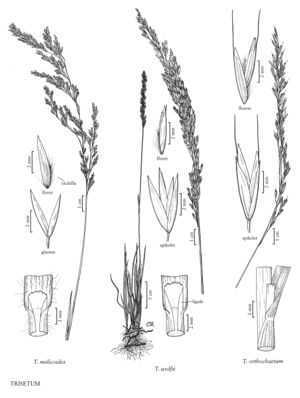Trisetum wolfii
Plants perennial, with both fertile and sterile shoots; shortly rhizomatous. Culms 20-80 (100) cm, erect, glabrous or retrorsely pubescent below the nodes. Leaves usually concentrated on the lower 1/3 of the culms; sheaths glabrous or sparsely retrorse-pilose, sometimes scabridulous; ligules (1.2)2.5^1(6) mm, truncate to rounded; blades to 15 cm long, 2-7 mm wide, flat, ascending, lax, smooth or scabrous, sometimes sparsely pilose, often involute near the sometimes prowlike apices. Panicles (10)20-40(50) cm long, usually 1-1.5 cm wide, stiffly erect, green, tan, or purple-tinged; branches appressed-ascending, the spikelets evenly distributed. Spikelets 4-7(8) mm, usually subsessile, rarely on pedicels to 4 mm, ovate, with 2(3) florets; rachilla internodes 1.5-2 mm; rachilla hairs to 1 mm. Glumes subequal, usually longer than the lowest florets; lower glumes 4-7 mm; upper glumes 4-6.5 mm, a little wider than the lower glumes; callus hairs shorter than 0.5 mm; lemmas 4-6.5 mm, lanceolate, firmer than the glumes, scabridulous-puberulent, obscurely bifid, unawned or awned, awns to 2 mm, arising just below and rarely exceeding the apices; paleas shorter than the lemmas; anthers (0.6)1(1.5) mm. Caryopses to 3 mm, pubescent. 2n = 14.
Distribution
Colo., N.Mex., Wash., Utah, Calif., Oreg., Alta., B.C., Sask., Mont., Wyo., Idaho, Nev.
Discussion
Trisetum wolfii grows in moist meadows and marshes, and on stream banks in aspen groves and parks in the spruce-fir forest zone, at medium to high, but usually not alpine, elevations. It is restricted to southwestern Canada and the western United States.
Selected References
None.
